Small surpluses for two PTAs
Page 24

If you've noticed an error in this article please click here to report it so we can fix it.
• Two Passenger Transport Authorities, in advance of the publication of their first annual reports, have announced small surpluses. They are Tyneside, which made a net revenue surplus of £84,000, of which £78,000 was from the Executive's bus operations, and Merseyside, with a net revenue of £313,768, after crediting the rate precept which brought in about £1,380,000.
In fact the Tyneside results cover the period from the establishment of the Authority on April 1 1969 to December 31 1970 although the Executive did not become operational until January 1 1970. The Merseyside results cover a period of 13 months, also ending on December 311970.
The Tyneside Executive achieved a gross operating surplus of £266,000; before provision for historic cost depreciation and other charges. Total bus operations income was just under £4m, presenting a revenue of 25.65 pcm, while expenditure amounted to just over £3-fm, representing 23.91 pcm.
Tyneside PTE claimed that these satisfactory results, which just met the financial target for 1970, were only achieved by the exercise of stringent control of overheads. A no-redundancy policy had been agreed but by non-replacement of staff and better utilization and organization of manpower, a 14 per cent reduction in workshop and administrative staff was effected, representing savings at the rate of £100,000 per year.
Labour cost-70 per cent The general reserve of £674,379 at December 31 1970 approximated the sum required to meet the additional costs of asset replacement at current price levels, Tyneside stated. About 70 per cent of the Executive's costs was for labour, 17 per cent for materials and servicing, five per cent represented indirect taxation and the remaining eight per cent was spent on renewal of assets.
Since the end of last year an agreement was reached with the NBC. which provided 49 per cent of the services in the PT Area, the statement continued, claiming that Tyneside was the first PTA to reach an agreement with the NBC. The basis was that the PTA would determine §ervices and fares subject only to approval by the Traffic Commissioners.
Although the year "was not an easy one nationally in the field of industrial relations". the Executive had been able to sign two local procedural agreements. The first was with the TGWU in respect of platform staff and the second with a number of unions representing craft and ancillary staff. The agreements recognized that it was in the interests of the Executive. its 'staff, • and the public they served that a policy of . good industrial relations should be established and operated.
Recently the PTA had approved the principle of a reserved track public transport system for Tyneside based on the recommendations in the Tyne Wear Transport Plan for the 80s. The Tyneside report and statement of accounts will be published as a single document early next month.
Merseyside PTA stated that the surplus was higher than that originally forecast primarily because last November's fare rise brought in more revenue than anticipated, and the charge for depreciation on a commercial basis had for technical reasons proved to be rather less than budgeted for when estimates were prepared on the lines employed by the former municipal transport undertakings. The surplus would hold down the new borrowing needed to replace buses, etc, and by saving interest charges would be of long-term benefit for the passengers.
Substantial progress had been made in the conversion of services to o-m-o. To date 37 routes have been converted and a comprehensive plan had been prepared to extend the programme so that by 1975 all services would be operated by one-man vehicles.
The new multi-journey ticket system launched in January 1970 had been extended throughout the period under review, and there were now 34 routes on which these tickets could be used. Available from newsagents throughout Liverpool and stores in the city centre, these Bus Economy Tickets provided for a discount of 20 per cent 10 rides at a given fare.
Another development had been the introduction of three "Rapidride" services between suburbs and the city. Stops were made in the picking up and setting down areas only, and the vehicles operated non-stop between the City Centre and the residential estates. On one of the services music was provided by means of tape recorders and had received approval from 82 per cent of the passengers.
On-the-spot fines?
Merseyside stated that the problem of over-riding and fare evasion justified consideration of a system of "on the spot" fines similar to those in operation in many Continental cities and in line with trends in this country—for example parking offences.
To improve the flow of buses radio links had been established between the control , room in Hatton Garden with more than 100 buses on both sides of the Mersey. The next 120 buses would also be fitted with radios. A revision of the main traffic movement in St John's Lane, Liverpool, had been made and included a bus lane in the direction of Lime Street. A bus lane had also been provided in Canning Place for a distance of about 75 yards to allow buses to move against the normal flow and maintain their link between South Castle Street and South John Street.
Further proposals for bus lanes were being discussed, but the PTA stated that progress towards further bus priorities was still unsatisfactory. The annual report and accounts are due for publication in the near future.




































































































